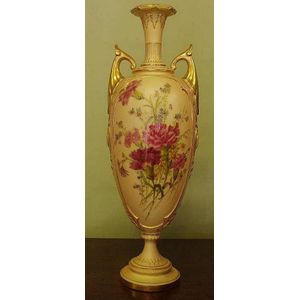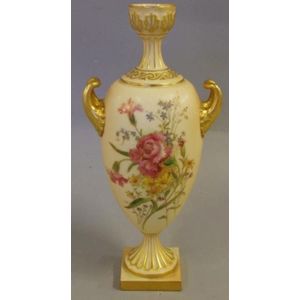Royal Worcester Thistle Vase by Edward Raby
You must be a subscriber, and be logged in to view price and dealer details.
Subscribe Now to view actual auction price for this item
When you subscribe, you have the option of setting the currency in which to display prices to $Au, $US, $NZ or Stg.
- Attributed - A cataloguing term where the item in the opinion of the cataloguers, is a of the period of the artist, craftsman or designer, and which probably in whole or part is the work of that person.
- Ivory - Ivory is a hard white material that comes from the tusks of elephants, mammoth, walrus and boar, or from the teeth of hippopotamus and whales. The ivory from the African elephant is the most prized source of ivory. Although the mammoth is extinct, tusks are still being unearthed in Russia and offered for sale.
Ivory has been used since the earliest times as a material for sculpture of small items, both in Europe and the east, principally China and Japan.
In Asia ivory has been carved for netsuke, seals, okimono, card cases, fan supports, animals and other figures and even as carved tusks.
In the last 200 years in Europe ivory has been used to carve figures, for elaborate tankards, snuff boxes, cane handles, embroidery and sewing accessories, in jewellery and as inlay on furniture. Its more practical uses include being used for billiard balls, buttons, and a veneers on the top of piano keys.
The use and trade of elephant ivory have become controversial because they have contributed to Due to the decline in elephant populations because of the trade in ivory, the Asian elephant was placed on Appendix One of the Convention on International Trade in Endangered Species (CITES), in 1975, and in January 1990, the African elephant was similarly listed. Under Appendix One, international trade in Asian or African elephant ivory between member countries is forbidden. Unlike trade in elephant tusks, trade in mammoth tusks is legal.
Since the invention of plastics, there have been many attempts to create an artificial ivory
This item has been included into following indexes:
- Raby, Edward (England) - Royal Worcester artists 9
-
Royal Worcester (England), item types
- other 3,388
- vases, other 1,161
Visually similar items

A Royal Worcester vase, of baluster form with moulded mask handles, the flared neck with pierced decoration, painted with flowers with, a puce mark shape 1047. 40 cm high

A Royal Worcester double handled urn vase, of ovoid form, the ivory ground ornamented with flowers, dragon handles, heightened in gilt, raised on square foot. Date code 1895, shape 1573, RN. 188127. Height 38 cm.

Large Royal Worcester double handle vase with handpainted floral springs, circa 1913, height 40 cm approx

Royal Worcester blush two handled vase, with hand painted floral springs. 22 cm high
